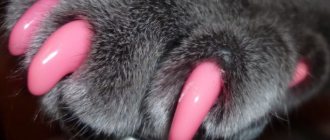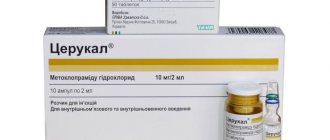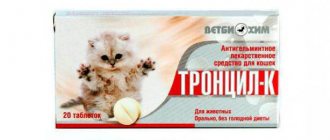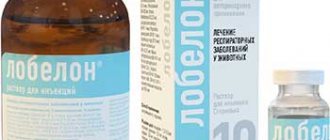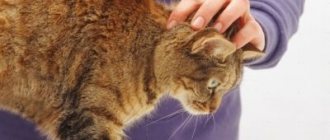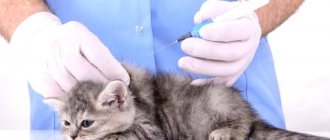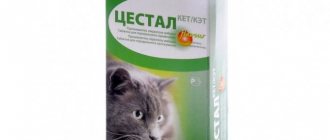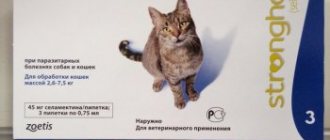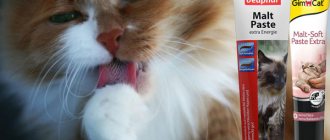Anti-scratch guards for cats are designed to protect surrounding objects and household members from the sharp claws of a pet. Popular silicone pads come in 4 sizes and can be used on kittens from 4 months of age (size XS for babies). To fix them, a special glue is used, which is included in the kit and does not cause allergies.
The service life of the covers is 1-1.5 months. It is not allowed to be worn for up to 4 months, if you are allergic to glue and for animals that walk outside, if there is a fungus or infection on the claws. On average, for a set of 40 nozzles you will have to pay up to 400 rubles.
An alternative to anti-scratch treatments can be a repeller spray (Beaphar Stop-it Cat, Biovax, Anti-scratch) and training the cat to use a scratching post.
What are anti-scratch products for cats?
Anti-scratchers for cats are silicone, rubber or plastic attachments. The useful accessory was invented as an alternative to onychectomy - a bloody operation to surgically remove a claw and part of a pet's finger. A wide selection of pet products allows you to choose anti-scratch products not only by type of material, but also by the size of your pet, and even by color.
Can it be used for kittens from 2 months of age?
Veterinary experts do not recommend using protective covers for kittens over 2 months old. Manufactured products, even of the smallest size, do not fit well on children. Curious pets can easily pick them off and swallow them. Anti-scratch products can be used starting from 4-5 months of age for a kitten. For these purposes, the smallest attachments in size XS are produced.
When you do and don't need claw protection for cats
You can use cat claw protection in the following situations:
- The animal is not accustomed to using a scratching post and damages furniture, walls, and foreign objects.
- There are small children in the house, and the pet is not always peaceful when it comes to children's games.
- Aggressive and evil character of the cat.
- Prevention of scratching when your pet is infected with fleas, develops allergies and other dermatological problems.
- The owner has health problems. Scratches from pets can cause allergies and are unsafe for bleeding disorders.
You should not use nail guards if:
- The animal has an individual intolerance to the material from which the accessory is made.
- The pet has free access to the street. A cat needs claws not only to climb trees, but also to protect itself from dogs and aggressive relatives.
- The main task of a cat is to hunt mice. The use of anti-scratches in this situation will negate all the hunting abilities of the animal.
Soft claws for dogs
Many people think that dog claws do not scratch. However, animal breeders know very well that this is not so. Perhaps a dog's claws are not as sharp as a cat's, but scratches can still often be avoided. The greater weight, more powerful muscles and irrepressible active nature of dogs mean that with their claws they can cause no less damage to furniture (and the owner) than their smaller counterparts.
There is a whole line of sizes of soft claws for dogs on sale. Anti-scratch guards can be selected for both small animals, such as Chihuahuas, whose dimensions are smaller than cats, and for large breeds (shepherds, Dobermans).
But still, dog anti-scratch products are less in demand than cat ones. At the same time, the smallest sizes are the most popular, used for small breeds that are often carried in the arms. Mostly positive reviews come from their owners.
Features of using claw pads for cats
Claw pads for cats have the following features:
- the size of the covers should be chosen taking into account the weight of the animal;
- Anti-scratch pads should only be glued with the special glue included in the kit;
- It is not necessary to put tips on all the claws; you can “disarm” only the front paws.
Pros and cons, possible complications of declawing protection for cats
Claw protection for cats has its advantages:
- cases allow you to protect valuables from damage;
- in case of a skin disease accompanied by itching, scratching is prevented;
- facilitate bathing and other hygienic or medical procedures for an obstinate cat;
- do not harm the pet;
- the covers can be put on the claws yourself;
- are inexpensive.
Anti-scratch pads also have their disadvantages:
- independent care of hair and ears becomes impossible;
- a cat with access to the street may become a victim of aggressive relatives or dogs;
- The animal cannot cope with the task of a mouser.
Myths about nail caps
Many myths about nail caps have not been confirmed:
- Myth No. 1. The devices prevent the animal from walking. Correctly sized and applied silicone pads do not affect the pet's gait. At first, out of habit, the cat may move uncertainly, but soon its former grace returns.
- Myth No. 2 . A cat cannot retract its claws if they are covered with covers. If the instructions are followed, the soft caps cover only 2/3 of the length of the claw and do not prevent their retraction.
- Myth No. 3 . Anti-scratch products are harmful to health. Properly selected and worn covers are safe for the cat. In rare cases, the adhesive used to secure them can cause an allergic reaction.
Cat's reaction to nail covers
When using claw covers for the first time, the cat’s reaction can be very negative: some cats try to get rid of an unknown object using their teeth. However, the durable material from which the device is made protects it from furry vandals.
The cat's gait may change. As a rule, animals quickly get used to the presence of caps on their nails and after a day or two they completely forget about their existence.
In rare cases, some pets may develop an allergic reaction to the material from which the protective accessory is made.
Are anti-scratch guards harmful to cats and who should not wear them?
The opinion that anti-scratch products are harmful for cats in most cases is due to their illiterate use. Over many years of foreign practice, no cases of threat to animal health have been identified when used correctly.
You cannot put attachments on the claws of cats that have access to the street and in case of individual intolerance to the material. The minimum age for kittens to use anti-scratch products is 4 months.
Reviews from veterinarians
Reviews from veterinarians about anti-scratch products are in most cases positive. If the owner follows the instructions for their use, experts consider this invention safe for the health of the animal. Some veterinarians have expressed the opinion that false nails prevent the cat from realizing its natural instincts and make grooming more difficult.
Basic questions when purchasing
When faced with the choice of whether to buy such devices for your pets or get by with the classic “sharpening” of claws/surgery, a number of related questions arise. For example:
- What happens if an animal swallows the bait? Nothing bad will happen. The caps are made of non-toxic material, have a smooth surface and, when ingested, can easily pass through the entire gastrointestinal tract and exit naturally.
- How quickly will the cat get used to the new condition? Everything is individual. Usually the adaptation process lasts 2-5 days, during which she may get nervous and try to chew or remove the interfering accessory, but then she gets used to it and resigns herself.
- Will the habit of sharpening your claws go away? No, the instinct remains, the animal will still release its claws, but it simply will not be able to harm furniture, walls, wallpaper or a person.
- Which manufacturer is better? The best brands that have proven themselves in this area are: Soft Paws Nail Caps For Cats (USA), Cliny, Crazy Liberty (Russia), Barbos (Russia).
You can now view the current price of silicone pads for cats and buy them right here:
Types of nail tips
Nail tips come in different types: silicone, rubber and plastic. A variety of colors has a practical meaning - the owner can see if the cover is lost, and it is convenient to find it in the room.
Advantages of using silicone pads
Silicone pads are the most popular among owners, since the material rarely causes allergies, adheres well and does not hinder the natural movements of the animal.
How to make anti-scratch for a cat with your own hands
If desired, the owner can make anti-scratch bars for a cat on his own, using silicone and polypropylene.
Advantages and disadvantages
Positive aspects of using anti-scratch for cats:
- Safety of household goods.
- Avoid scratching the skin when the animal is sick.
- Facilitation of hygienic and medical procedures.
- Self-sticking and removal.
- Availability of material.
But it is worth considering the disadvantages of this procedure:
- The cat will not be able to fully clean its fur and ears.
- Chewed off plastic caps can be swallowed by a cat.
- If the animal ends up on the street, it will not be able to run away from the enemy into a tree or fight back.
- You can also forget about catching mice.
View this post on Instagram
Posted by Marina Grumer (@marinagrumer) Aug 15, 2021 at 12:00 pm PDT
How to put on your cat's nails
You should put false nails on your cat after the claws have been trimmed. If separation of the stratum corneum is observed, then it is necessary to trim the surface with a file.
How to properly glue a cat's nails
The following instructions will help you glue your cat’s nails correctly:
- prepare 5 silicone caps from the package;
- apply a small amount of glue into the cavity of the nozzle (no more than 1/3 of the volume);
- disinfect the claws on the cat’s paw with an antiseptic;
- Having pressed on the crumb, extend the claw and place the cap on it, gently pressing it on all sides;
- similarly glue attachments to all the pet’s claws;
- when the anti-scratch for the cat is glued, the animal should be held so that the glue sets, and after 10-15 minutes the cat with false nails can be released;
- Glue from the owner's fingers can be removed with nail polish remover.
If the pet is mischievous and breaks out, then you can attract an assistant and wrap the cat in a blanket for the procedure.
Anti-scratch for cats: instructions on how to use
There are no special instructions for using anti-scratch pads for cats; the animal simply wears them until they either rip them off or they fall off along with the renewal of the nail. If your pet chews and eats the cover, it’s okay. It will come out naturally without damaging the walls of the stomach and intestines.
Anti-scratch glue
Glue is included with the cases. A non-toxic product is used to attach silicone tips. In rare cases, the glue used to attach false nails can cause an allergy in your cat.
How to remove anti-scratch pads from a cat's claws
You can remove scratch guards from your cat’s claws when the stratum corneum of the claw grows back. In this case, the nozzle disappears on its own. This happens after about 1-2 months, depending on the intensity of the natural processes of claw regrowth in the cat.
If you need to remove them a little earlier, then you need to carefully trim the tip of the cover and pull it off.
Anti-scratch alternative
An alternative to anti-scratching can be a cat repellent spray, training the animal to use a scratching post, or special socks.
Anti-scratch spray
Anti-scratch sprays contain repellent substances, such as essential oils, which furry creatures do not like. The most popular repeller sprays among owners are Beaphar Stop-it Cat, Biovax, Antiscratch (True Friend) and Antiscratch pheromones for cats.
Scratchy
A scratching post or scratching post is a device for grinding down claws in apartment living conditions. You can purchase a horizontal or vertical modification at a pet store. Most often, jute rope, sisal, and corrugated cardboard are used for its production. Some pets will like a wooden scratching post.
Getting used to using the device will not be difficult if you buy a finished product specially impregnated with aromatic agents.
